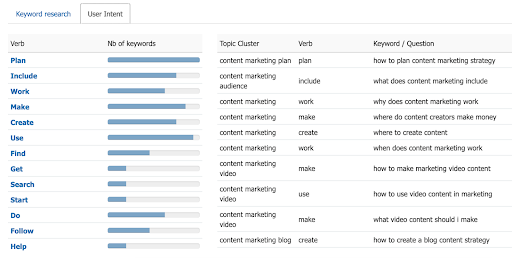
Content marketing is changing, but, luckily, there are smart tools that support the innovation and allow content marketers to stay up-to-date with new technology.
In this roundup, I am going to stay off the beaten path and suggest some tools that are not being featured in every other article for you to try something new and discover new ways to look at your data.
The following content marketing tools deserve all the spotlight they can get as they are new, fresh and bring innovation into our marketing:
Keyword Research & Content Ideation Tools
1. WebCEO
WebCEO is a comprehensive all-in-one SEO platform that deserves a lot more attention than it is currently getting. It has quite a few unique features one of which is its keyword research tool allowing you to pull keyword suggestions from multiple sources. It shows search trends for each keyword it suggests and allows you to easily estimate how competitive it is in organic search.
WebCEO has quite a unique approach to identifying keywords with high demand (i.e. search volume) and “doable” competition (i.e. those search queries that are easier to generate traffic from). The metric is referred to as The Keyword Effectiveness Index (KEI). It is calculated based on the search volume and the number of search results returned by Google search.
A keyword with a relatively higher KEI is supposed to have a higher demand and lower supply, so it should be easier to compete for.

You can also easily group those keywords by using tags and filter your keyword suggestions to target a specific location (e.g. a state or a city your business is focused on)
WebCEO has many more features your whole team may find useful which include competitor tracking, website speed optimization and more.
2. Also Asked
A new tool by @thetafferboy, Also Asked, allows you to analyze Google’s “People Also Ask” results and how they relate to one another.

You may know that Google will generate more answers based on which question you chose to click. Also Asked will explore this connection by showing you visually how each level of questions is topically grouped with the next.
The tool offers a nice insight into intent-based search journeys your target audience is likely to take when researching any topic.
3. Glimpse
Glimpse is a freemium Google Chrome extension that makes Google Trends reports much more useful by adding lots of useful SEO insights to it. As you are checking Google Trends for your target term, Glimpse will add more data which includes:
- Search volume for that search query
- “People Also Search for” (these keywords are extracted from Google) that is related to that query
- Popularity of that term on social media channels (Channels that score high indicate that your keyword’s usage on that channel is higher than average)
- Related trending queries
- Topic map showing related topics for you to keep researching the topic

Content Collaboration and Creation
4. Narrato
Content creation is no longer a straightforward process as it was traditionally perceived. Content writers should incorporate a lot of data into the copy for it to be in-depth, search-intent driven and properly optimized.
Narrato is the AI-driven tool that can put many of those pieces together by allowing you to put together detailed content briefs and content workflows and even find content writers with the right expertise.
For every piece you are working on, create a new project inside Narrato and start by generating a content brief using AI-driven tools it offers. The tool helps you by generating relevant keywords and questions, assists in structuring your future article subheadings and allows you to create a style guide for your writers to follow. You can also use the AI-powered image generator to locate related images to use in your content (with attribution).

You can write the article right inside the editor and publish it directly to your WordPress site right away. Or you can assign your writers to complete it based on your brief using the workflow feature. The platform also gives you access to AI content marketplace in case you need to find expert articles to write for you.
The platform can enhance your content creation productivity by connecting different teams, giving you access to templates and letting you use AI tools to manage all steps in the content production process:

Semantic Research Tools
5. Text Optimizer
Text Optimizer is not a new tool (I’ve mentioned it a few times already), but there is still no alternative to it as I know of.
One of its features, called “sentence builder”, allows you to explore connections between your chosen concepts and build sentences that would use your important terms in close proximity. It is a great way to understand your topic better and create better optimized content.

6. Inlinks
Inlinks is the new semantic analysis tool that uses Google’s API to help you optimize your content for “things, not strings”. It helps in the following three key areas:
- Optimize your content around semantic search
- Auto-generate content briefs based on your target topic using semantic analysis
- Semantic keyword research that is based on meaningful clustering and an innovative approach to satisfying user intent. This is their newer feature that will make your content and intent optimization process much more effective.
The tool generates not only keyword suggestions that relate to your target audience’s search intent, it also finds related questions that add context to your seed keyword and let you structure your future content more effectively.
Make sure to use “Intent” tab to let the tool suggest actionable insight into how to make your content align with what people need when using your core search term:

All those insights from these three tools can be added to the content brief inside Narrato for your writing team or collaborators to include in the copy.
Content Structuring Tools
8. ChatGPT
ChatGPT was launched at the end of 2022 and took the whole world by storm. It is a conversational smart chatbot that can perform just about any basic marketing task out there. Honestly, it can fall into many categories in this list as it can help you with your content strategy on many levels, including keyword classification and ideation.
I wouldn’t recommend using it for writing content though because the produced content lacks style and real expertise/experience with the discussed topic. It is also easily detectable as AI-generated content, so you can easily get penalized by Google if you use it for content creation.
Using the tool to structure your content is a better idea though. You can ask it to structure your existing content, for example, and the tool will break your article into logical sections and even provide an HTML code the newly generated subheadings:

There are many more AI-powered tools, including Jasper, and conversational marketing solutions (like customer support chatbots and IVR) to check to find ways how they can improve your marketing strategy.
Content Outreach Tools
8. Link Hunter
These days, it is hard to imagine a content marketing campaign that wouldn’t include email outreach. The truth is, just a few short years ago, we didn’t have to do that much to get our content seen by key industry media outlets and bloggers.
Now, with content consumption exceeding content demand in many niches, getting your content in front of industry influencers for them to give it wings is the only way to see it spread.
Link Hunter is a valid alternative to a multitude of outreach tools as it is very easy to set up and offers all the outreach features you may need at a very affordable price (for about 500 hundred emails per month, you’ll only need to pay $50).

From prospect discovery to email status tracking, Link Hunter is a solid outreach solution that is suitable for smaller businesses that want to handle outreach in-house at a reasonable price.
There are also quite a few smart email marketing platforms that can be used for outreach and content outreach purposes.
Competitive Intelligence Tools
9. Side-by-Side SEO Comparison Tool
On-page content is not the only ranking factor, of course, but it is always useful to look at your successful competitors’ content and compare it to yours. More often than not, that uncovers some new tactics to experiment with and integrate into your content SEO workflow.
This Side-by-Side SEO Comparison Tool is the only 100% free tool on this list and it allows you to easily compare your page to your competitors. As the name suggests, the tool creates the side-by-side comparison of key content elements that may have some impact on organic search visibility, including:
- Titles and meta descriptions
- HTML headings
- Keyword usage
- Internal and external links
- Content length, etc.

Conclusion
To remain competitive, every brand needs to stay on top of key technologies and innovations that are driving change in the content marketing industry.
The good news is content marketing technology is advancing at a fast speed, meeting the demand for smarter, more integrated and cross-platform marketing software.
These days, content marketers have a wide variety of advanced applications from which to choose, including advanced content ideation and development tools, smart analytics and conversion optimization suites, enhanced outreach and relationship building platforms, and more.



